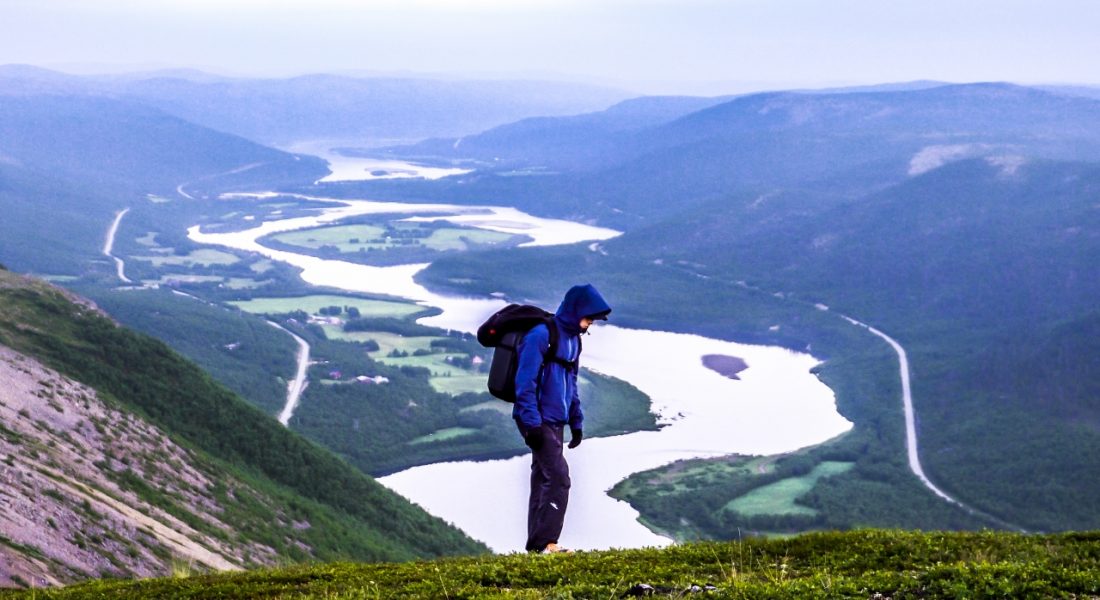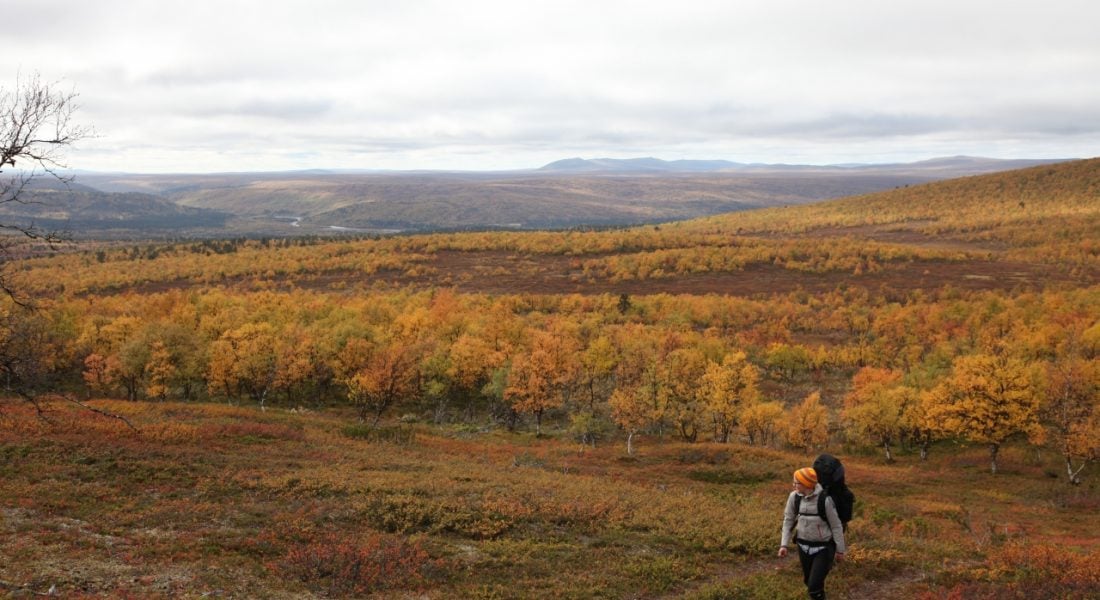Hiking trails in Utsjoki area
Utsjoki is one of the most beautiful destinations for a hiker. Fells, canyons and waterfalls all surrounded by the enchanting arctic nature of an experience to remember.
There are many hiking trails intended for day trips in the fells surrounding the villages of Utsjoki, Nuorgam and Karigasniemi as well as longer paths, suitable for multi-day hikes. Actually, hiking is one of the best ways to explore this beautiful region.
The hiking trails are open to everyone free of charge. Bonfires is allowed only at specifically marked sites. All the trash taken by you into the nature must be carried back and recycled.
You can find all the trails in Utsjoki area in InfoGis and Retkikartta maps.
Short trails
Most of the shorter trails follow old, established paths winding along at the foot or on the slopes of fells. The trails are marked by poles and signposts, and duckboards have been built over particularly swampy or difficult-to-cross areas. The day trails are generally easy walking except in the steepest parts of the paths. There are open-for-everyone goahtis along many of the paths, that are intended for daytime use and are not suitable for overnight stays.
Salmon trail 1.7 km, Utsjoki
The Salmon Trail starts at Onnelantörmä (parking lot approximately 100 metres from the Sámi Bridge) and passes through the underpass towards the bank of the River Utsjoki and along the river back to the Nuorgamintie Road. The trail is not unobstructed, but the terrain is mostly easy and primarily runs through a mountain birch forest.
The Ulrika trail 2.3 km, Utsjoki
The Ulrika Trail runs in the neighbourhood of the Utsjoki Church, in a nationally important cultural environment. The church, the parsonage and its surroundings, the church huts, the sacristy of St. Ulrika with its church yard and the trading place have all been protected by the Finnish Heritage Agency. The church hut association, Utsjoen kirkkotupayhdistys, has built the culture trail in this area, and it tells also about Sámi architectural and cultural history.
Kalkujoenlampi trail 5.9 km, Utsjoki
Starting from the centre of Utsjoki village (address Miessipolku 4) and following a trail up a fell, the Kalkujoenlampi trail offers beautiful views on the village and surrounding fells. There is a goahti by the path as well as a place for a bonfire with views on a pond. From there, the trail follows Annakuru (Ánnagurra) down to the Utsjoki school. This part of the path is very steep and demanding.
Skalonjuovčča trail 5.8 km, Karigasniemi
The starting point of the trail is 6 km from Karigasniemi village towards Kaamanen, by the road of Ailigas fell. The trail goes up the western side of Aligas fell, from where you have a beautiful view overlooking the rivers Inarijoki, Karasjoki and the mighty river Teno as well as the Norwegian fells. The trail continues up to a goahti. The trail is fairly easy and returns the same way.
Skaidijärvi trail 5.8 km, Nuorgam
The Skaidijärvi trail is on of the most popular trails in Utsjoki region and for a good reason. The trail is easy to walk with beautiful views on the fells surrounding Nuorgam village. The start of trail is by the road Pulmankijärventie. There is a goahti by the trail with firewood and a place to make bonfire.
Wilderness hiking routes
Utsjoki wilderness trail 25 km or 35 km, Utsjoki
The trail starts from Utsjoki village (address Miessipolku 4). The trail travels through the Paistunturi wilderness area, ending near Utsjoki Church at lake Mantojärvi. The trail is surrounded with fells, lakes and beautiful river valleys. The highest fell seen from the trail is Roavveoaivi (466 m) from top of which you can see the snow-covered top of famous Rastigaisa fell in Norway.
If you want to hike the whole 35 km, you continue from Utsjoki church all the way back to the village. From the church the trail climbs up to Alaseitikkovaara (Vuolleseavttetvárri 299 m) before descending back to the village.
Kevo trail 63 km, Karigasniemi and Utsjoki
Kevo trail is said to be the most magnificent hiking trail in Finland. The trail crosses Finland’s biggest strict nature reserve, offering a beautiful experience in the heart of arctic nature. The trail is known for the Grand Canyon of Finland, Kevo Canyon. In fact, the most of the trail follows the canyon, partly on top of the surrounding fells, partly down in the canyon. Other scenic views of the trail include for example Fiellu waterfall. The trail crosses the River Kevo three times which is an experience to remember as the water never gets warm here. All in all, the trail is rocky and very demanding for which reason it is only recommended for experienced hikers. For the ones less experienced or if you’re after a safer and more comfy experience, we recommend hiring a local guide to assist you.
Kuivi trail 86.5 km, Karigasniemi and Utsjoki
The Kuivi trail shares partly the same path as Kevo trail passing by the spectacular view over Kevo Canyon as well as Fiellu waterfall.
Sevettijärvi–Pulmanki wilderness trail 60–70 km, Nuorgam
The Sevettijärvi-Pulmanki hiking trail travels in the eastern side of Kaldoaivi wilderness area. The southernmost point of the trail is in Sevettijärvi in a traditional Skolt Sámi village. The northernmost point is at the sothern end of Pulmankijärvi lake, 20 km south of Nuorgam.
The trail itself is not demanding but some of the water crossings may be challenging especially in early summer. The trail travels through the biggest wilderness area in Finland for which reason for example in case of an emergency getting help might take a long time. Also, there are parts with no functioning mobile network.
There are wilderness huts along the road, open for everyone. The principle of using the huts is first-in-first out, for which reason you should always make room for people arriving after you.
Safety
Utsjoki is situated 450 kilometres above the arctic circle which means it might get very cold, even minus degrees, also in the summer. Therefore you should always carry a lot of warm clothes with you.
Up in the fells the weather changes very quickly and you might also lose visibility. Sometimes it snows also in the summer. Steep, rocky landscapes and long distances demand good physical shape. The wilderness areas do not have roads, meaning that in the worst case it might be more than 40 kilometres to the closest road. In the case of an emergency, getting help might take a long time. There is no mobile network in parts of the wilderness areas. There is a lack of firewood in many places. For all of these reasons comprehensive outdoor skills are needed.
We recommend taking the marked trails. Always equip yourself thinking of the worst case scenario. Always carry a first aid kit with you. Carry more food and water than you think you need, excess warm clothes and be prepared for quickly changing weather.
Always inform someone about your travel plans. For beginners or someone who is not experienced in hiking in the arctic nature we recommend taking a local guide with you. Everyone explores the wild at one’s own risk.











